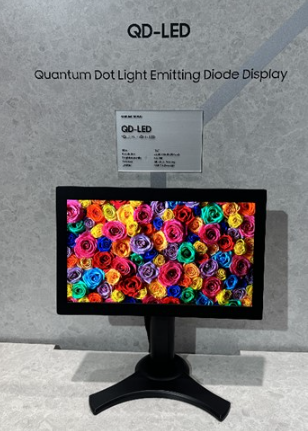
From May 14th to 16th, the international display industry's leading event, SID Display Week 2024, was held in San Jose, USA. Major panel manufacturers such as BOE, TCL CSOT, Tianma, Visionox, Innolux, AUO, Samsung Display, and LG Display showcased a variety of new technological products. TrendForce will review and summarize the development focuses of various panel manufacturers from a technical perspective.
3D Display Makes a Comeback, Focusing on Glasses-Free Immersive Experience
3D visual perception is currently the most intuitive way humans perceive the world. Compared to AR/VR, which requires additional wearable devices, glasses-free 3D technology allows users to enjoy a lifelike visual experience without the need for glasses or headsets.
With significant improvements in display quality and user experience, this technology can now be applied to museum exhibits, outdoor advertising, medical education, and more. It has the potential to compete with emerging head-mounted devices in the future.
At the exhibition, in addition to 2D/3D switching, there were light-field displays that enhanced monocular resolution to retinal levels. Coupled with facial tracking and active human-machine interaction systems, these displays expanded the viewing range and 3D viewing angles, delivering an immersive and impressive desktop 3D display experience.

BOE: 110”16K 3D Display & 32”Light Field Display

LGD: Micro OLED+ Light Field Display
Performance – Enhancing Efficiency to Meet AI Era Demands for Improved Image Quality and Reduced Power Consumption
Addressing the power consumption issues brought about by enhanced image quality can be achieved through various technological advancements such as pixel design, tandem architecture, AI intelligence, micro-lens arrays, oxide backplanes, and dynamic refresh rates. These innovations aim to improve image quality while simultaneously reducing power consumption.
For instance, oxide backplanes have significantly lower leakage currents compared to LTPS backplanes. Combined with new circuit designs, they can maintain voltage for extended periods, keeping flicker within a certain frequency during low-frequency refreshes. Dynamic refresh rates allow the screen's refresh rate to adapt based on the content displayed, aligning refresh rates with display signals in real-time to provide longer battery life.
With the rapid development of artificial intelligence, AI technologies are being leveraged to enhance image quality while reducing screen power consumption (AI low-power image enhancement technology). The deep integration of AI with screens enables real-time image processing at high resolutions and refresh rates, reducing the power consumption of panel modules and achieving an optimal balance between reduced power consumption and improved image quality.

BOE: AIoT + OLED AI Power Reduction Technology
Folding – Diversified Folding Designs Expanding Application Scenarios
At the exhibition, panel manufacturers showcased the durability of foldable screens through tests involving robots randomly striking the displays, demonstrating that foldable screens can now meet the demands of most usage scenarios.
In addition to the conventional inward and outward folding screens already available on the market, the exhibition also featured G/Z-shaped tri-fold phones and new foldable plus extendable display panels, allowing users to switch between different screen sizes based on application needs.
The introduction of various flexible display forms includes innovations such as the removal of polarizers, simplified hinges, and stress-designed screens, preparing for a variety of user experiences and interaction modes with the new foldable display panels. These complex module designs are expected to drive technological innovation within the supply chain.

SDC: Foldable OLED Reliability Test

SDC: Flex Note Extendable (Folding+ Sliding) Display Size: 13.8” -> 17.3”

SDC: Flex S Multi Foldable Display (Z-Shaped)
Transparent Displays – Enhanced Transparency Technology for Better Integration with Environments
Once a futuristic display technology with a sci-fi aura, transparent displays are now being gradually applied in commercial, automotive, and everyday scenarios by various brands. Transparent displays transform glass from a mere transparent material into a display product with vast imaginative potential and rich content.
The key to enhancing screen transparency lies not only in the transparency of the substrate but also in effectively increasing the pixel aperture ratio to maintain image quality. Historically, Micro LED screens have achieved transparency rates of over 60%, while OLED screens have been around 40%. With recent technological improvements, the OLED screens showcased at this exhibition have now reached a 60% transparency level, matching that of Micro LED screens.
The future of transparent displays will be shaped by continued advancements in transparency, image quality, brightness, price, and product positioning. Higher transparency levels will enable seamless integration with environments, facilitating broader application and adoption of this innovative display technology.

Visionox: 10” Transparent OLED (Transparency: 60%)

AUO: 60” Transparent Micro-LED Display (Transparency: 60%)
New Applications and Technological Breakthroughs
At the exhibition, notable breakthroughs in new applications and technologies
included innovative automotive display designs, QDEL displays produced through
printing processes, and high-brightness RGB OLEDos. Samsung Display and TCL CSOT
both showcased QD-OLED-related technologies, employing printing methods to add
quantum dots that directly convert light into colored images.
In traditional QLED technology, the light source is blue backlight that passes through quantum dots for color conversion. In contrast, the QDEL displays exhibited by Samsung Display and TCL CSOT apply current directly to the quantum dots to generate light. As a result, QDEL pixels can emit light and switch off independently, offering the same deep blacks and rich contrast as OLEDs.
Looking ahead, as the lifespan of the quantum dot light-emitting layer improves, QDEL is poised to become a competitive choice for consumer displays due to its lower cost and superior image quality.

Samsung: 18.2” QD-LED

BOE: P0.3 Micro LED Transformer Display Cluster <-> Center Information Display (CID) Co-Driver Display (CDD)

TIMANA: 12.3”InvisiVue Display With Textured, Mini-LED

Visionox: Rollable OLED Surface Display
Green Low-Carbon Technology Industry Development Trends
It is noteworthy that LG Display has focused on developing new technologies under the theme of a better future. BOE, in particular, has set up a green low-carbon zone at the center of their booth, highlighting green manufacturing, green product technology, and green supply chains.
They continue to lead the display industry with technological innovation and green development, promoting the healthy and sustainable growth of the global display industry.


BOE: Green for Future















